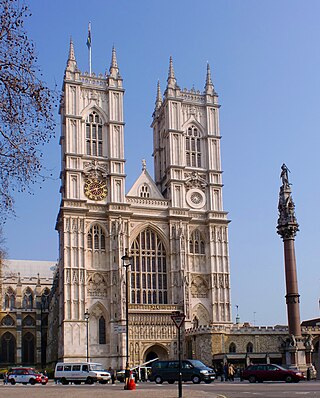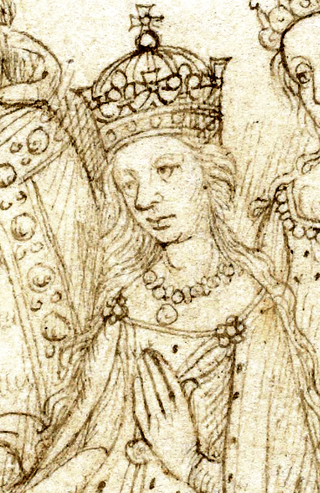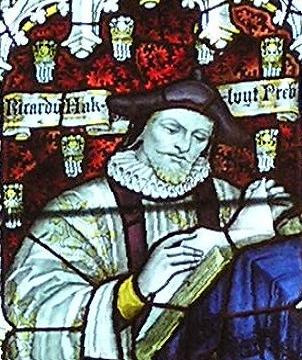Related Research Articles

Westminster Abbey, formally titled the Collegiate Church of Saint Peter at Westminster, is an Anglican church in the City of Westminster, London, England. Since 1066, it has been the location of the coronations of 40 English and British monarchs, and a burial site for 18 English, Scottish, and British monarchs. At least 16 royal weddings have occurred at the abbey since 1100.

Catherine of Valois or Catherine of France was Queen of England from 1420 until 1422. A daughter of Charles VI of France, she was married to Henry V of England and was the mother of Henry VI. Catherine's older sister Isabella had also been a Queen of England as the child bride of Richard II. Catherine's marriage was part of a plan to eventually place Henry V on the throne of France, and perhaps end what is now known as the Hundred Years' War, but although her son Henry VI was later crowned in Paris, this ultimately failed.

Matthew Paris, also known as Matthew of Paris, sometimes confused with the nonexistent Matthew of Westminster, was an English Benedictine monk, chronicler, artist in illuminated manuscripts, and cartographer who was based at St Albans Abbey in Hertfordshire. He authored a number of historical works, many of which he scribed and illuminated himself, typically in drawings partly coloured with watercolour washes, sometimes called "tinted drawings". Some were written in Latin, others in Anglo-Norman or French verse.
Thomas Walsingham was an English chronicler, and is the source of much of the knowledge of the reigns of Richard II, Henry IV, Henry V and the latter reign of Edward III depicting the decline of the state of affairs of the English. He also documented the careers of John Wycliff and Wat Tyler.
Roger of Wendover, probably a native of Wendover in Buckinghamshire, was an English chronicler of the 13th century.

Thomas Sprat, FRS was an English churchman and writer, Bishop of Rochester from 1684.

Richard Hakluyt was an English writer. He is known for promoting the English colonization of North America through his works, notably Divers Voyages Touching the Discoverie of America (1582) and The Principal Navigations, Voyages, Traffiques and Discoveries of the English Nation (1589–1600).

The Flores Historiarum is the name of two different Latin chronicles by medieval English historians that were created in the 13th century, associated originally with the Abbey of St Albans.

Matthew Prior was an English poet and diplomat. He is also known as a contributor to The Examiner.
Richard of Cirencester was a cleric and minor historian of the Benedictine abbey at Westminster. He was highly famed in the 18th and 19th century as the author of The Description of Britain before it was proved to have been a later forgery in 1846.

Jean Chardin, born Jean-Baptiste Chardin, and also known as Sir John Chardin, was a French jeweller and traveller whose ten-volume book The Travels of Sir John Chardin is regarded as one of the finest works of early Western scholarship on Safavid Iran and the Near East in general.

Ephraim Chambers was an English writer and encyclopaedist, who is primarily known for producing the Cyclopaedia, or an Universal Dictionary of Arts and Sciences. Chambers' Cyclopædia is known as the original source material for the French Encyclopédie that started off as a translation of Cyclopædia.

The Ormulum or Orrmulum is a twelfth-century work of biblical exegesis, written by an Augustinian canon named Orm and consisting of just under 19,000 lines of early Middle English verse. Because of the unique phonemic orthography adopted by its author, the work preserves many details of English pronunciation existing at a time when the language was in flux after the Norman conquest of England. Consequently, it is invaluable to philologists and historical linguists in tracing the development of the language.

Louis-François Roubiliac was a French sculptor who worked in England. One of the four most prominent sculptors in London working in the rococo style, he was described by Margaret Whinney as "probably the most accomplished sculptor ever to work in England".

A Lady chapel or lady chapel is a traditional British term for a chapel dedicated to "Our Lady", Mary, mother of Jesus, particularly those inside a cathedral or other large church. The chapels are also known as a Mary chapel or a Marian chapel, and they were traditionally the largest side chapel of a cathedral, placed eastward from the high altar and forming a projection from the main building, as in Winchester Cathedral. Most Roman Catholic and many Anglican cathedrals still have such chapels, while mid-sized churches have smaller side-altars dedicated to the Virgin.

John of Wallingford, also known as John de Cella, was Abbot of St Albans Abbey in the English county of Hertfordshire from 1195 to his death in 1214. He was previously prior of Holy Trinity Priory at Wallingford in Berkshire, a cell of St Albans.

The Chronica Majora is the seminal work of Matthew Paris, a member of the English Benedictine community of St Albans and long-celebrated historian. The work begins with Creation and contains annals down to the year of Paris' death of 1259. The Chronica has long been considered a contemporary attempt to present a universal history of the world.
John Le Neve (1679–1741) was an English antiquary, known for his Fasti Ecclesiæ Anglicanæ, a work of English church biography which has been published in many subsequent editions.

John of Wallingford was a Benedictine monk at the Abbey of St Albans, who served as the abbey's infirmarer at some time between c.1246-7 and his death in 1258. He is now mostly known through a manuscript containing a miscellaneous collection of material, mostly written up by Wallingford from various works by his contemporary at the abbey Matthew Paris, which survives as British Library Cotton MS Julius D VII. This manuscript includes the so-called Chronica Joannis Wallingford or Chronicle of John of Wallingford.
Thomas Sprott or Spott was an English Benedictine chronicler, a monk of St Augustine's Abbey, Canterbury.
References
- ↑ Herbermann, Charles, ed. (1912). . Catholic Encyclopedia . Vol. 15. New York: Robert Appleton Company.
- ↑ Brayley, Edward Wedlake (1818). The History and Antiquities of the Abbey Church of St. Peter, Westminster. Vol. 1. London: J P Neale. p. 69.
- Attribution
This article incorporates text from a publication now in the public domain : Chisholm, Hugh, ed. (1911). "Matthew of Westminster". Encyclopædia Britannica . Vol. 17 (11th ed.). Cambridge University Press. p. 899.